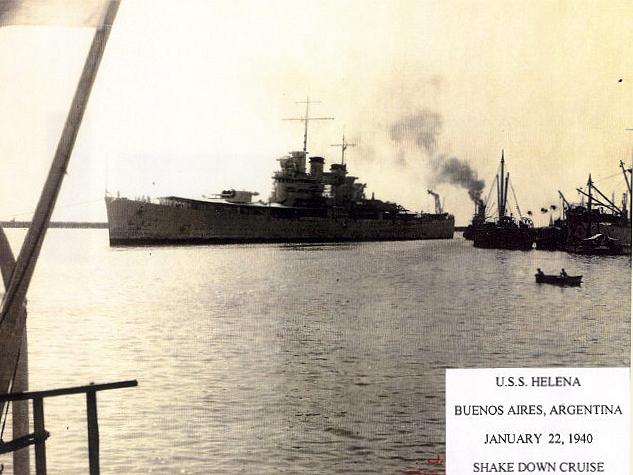
The above picture donated by Charles McClelland, USS Helena CL-50.
The story that follows has been copied from "Our Navy" Magazine dated First of May 1940.
Provided by George Del Gaudio
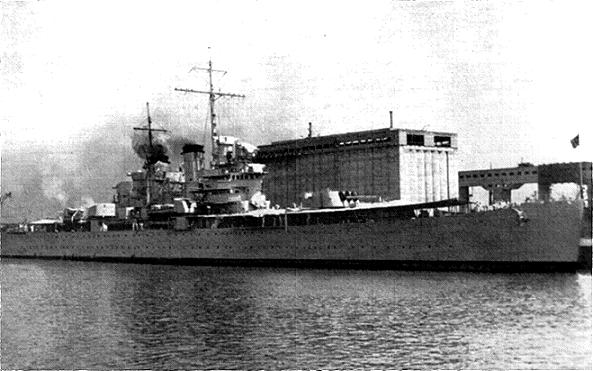
The Good Ship Helena in Buenos Aires.
|
|
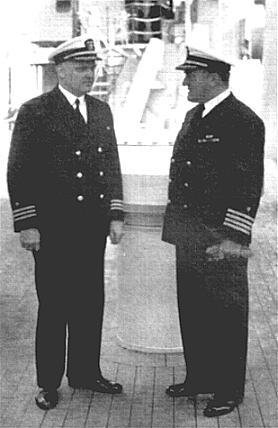
Captain M. B. DeMott, Commanding
Officer, and G.C. Richardson, Executive
Officer of the Helena.
|
The Helena Shakedown
By R. E. HARRISON
LEAVING the Times Square bright lights on December 21, 1939 for the Holidays in Annapolis, the HELENA started on her shakedown cruise to South America and Neptune's Royal Realm with over four hundred pollywogs to be worked over.
The HELENA spent four days in Annapolis, with all the recruits wishing for last year's Santa Claus, and four days in Norfolk to take on aviators, last-minute supplies and "Bunny" Park's cargo of jute boxes, saxophone tooters and sundry other rug cutters who turned out to be one of the high-lights of a very pleasant cruise. January 3rd saw us off to a warm sojourn of two days in Guantanamo to paint, scrub and hoist a few mugs of Americano beer-the last good beer to be had until anchoring off Deer Point on the way home.
Learned that Pat Moonan was still alive and turreting on the Wichita. Hadn't heard of him since he was skipper of Number One of the SALT LAKE CITY ''way back when a 10,000 tonner was a novelty. Charlie Freeman stoking in the Vincennes and getting sentimental about the Richmond. Hicacal seems to be getting a favorable play now that Guantanamo sea duty is more popular than ever.
No sooner did the HELENA get stretched out on the long drag to the land down under, the recruits began showing up at all meals and feeling salty. Smooth sailing prevailed for a few days and the Iron Men of the Old Navee noticed nothing amiss other than an unusual number of flying fish and Portuguese men-o'-war. Gradually, however, the atmosphere became more tense and certain low-lifers began to sneak around and act as if a kittenish grin was a passport Foyal immunity. Rumor was rampant that the head, brig and CO2 locker were going to be jammed with loyal subjects of Davy Jones before the final atonement. Like all such low and nefarious mutinies this nasty plotting was quelched in the bud very effectively the night before by the flying wedge method employed by the Rex Squad of The Neptune Vigilantes. A few arms,legs and scalps were swept up after "The Battle of the Brig" but than numerous honorable and life-long scars, not a man managed to lose his head and the participants limped hack to their respective corners licking their wounds until further orders from the Briny Deep. Chief Boatswain Coffey, as Neptunus Rex, took over been Captain DeMott and issued stern and rigorous orders that kept the passageways practically cleared and even not jamoke was at a premium. Not a few rebels were handcuffed to bunks but the Royal Police maintained the strictest order throughout the night and kept the situation well in hand.
Sunrise of January 13 found the decks cleared for action with more lookouts stationed than Columbus had on the SANTA MARIA. However no reward of filthy gold was offered for the sighting of a landlubber's dream in this case. One peacoated and beleggined scum was heard to whisper that he would gladly swap his billet for a cool niche on the Marmerheim Line. Chief Gunner Anderson, Chief Gunner's Mate in 1904, with more trips across the Equator to his credit than a Marine has medals, had previously been elected Davy Jones and issued a set of hawser-hued whiskers, his physique and complexion being perfect otherwise. The ceremonies started with the usual fanfare and ruffles but the Royal Bears were champing at their bits, so things began to happen. Lieut. (jg) Folsom was the first initiate to go the full course. Commander Slingluff and Commander Maher (MC) got off with a severe bawling out from a bloddy bloke by the name of Novak. All eyes were glued to the final exit trying to get a check on what would transpire within the short period of incubation-and was it a honey! Polly-wog Folsom started out as a nervous, temperamental Seabiscuit and finally had to be pulled out looking like a ten-minute colt, only he did not have four legs to prop himself upright and had to be lashed down to keep the fire hose from washing him overboard. From there on it was a nip and tuck affair with all hands emerging better versed in the art of being a good and under-standing shipmate.
Read and see pictures of the CL-50 Shellback ritual, click HERE
Arriving at the mouth of the Rio de la Plata (River of Silver), on January 22, approximately 165 miles from Buenos Aires, all hands started looking over the horizon for the remains of the Graf Spee. Nothing was seen of the former raider on the trip in but with a little imagination one could make out the landmarks mentioned in various news and radio comments. One thing that strikes the casual observer in going up the River to Buenos Aires is that the Plata Delta extends quite a distance from the mouth of the river at Tigre; a narrow channel must be followed for about thirty miles before entering the port proper.
Buenos Aires (Good Air) is a surprise to anyone who has never stopped to study this southern metropolis; it is the largest city in South America, third largest on the American continent and second largest Latin city in the World. Like Washington, D. C., it is almost perfectly laid out with streets and avenues. Since 1936 it has grown from a population of two million five hundred thousand to over three million. The European War has started a boom in almost every kind of business and although things are going well now the Government is concerned as to what will happen when the huge demand for beef, pork, wheat, hides, etc., is suddenly shut off. There were at least seventy-five large English ships feverishly loading and unloading at the docks while the Helena was in port. The four-masted Moshulu, the largest windjammer in the world flying the Finnish flag happened to be loading wheat and rye for a return trip to Finland and Denmark during our stay. All hands can some day say that they remembered seeing the last of the "Flying Clouds" for she is destined to be tied up for the duration of the present war after arriving back in her home port.
During one of the sightseeing trips the bus stopped at one of the large docks and we went inside to see Argentine hides being loaded-mostly for England. Imagine hides stacked to the roof for a block square! Until about a year ago some of the inland stock raisers burned the carcasses of beef and sold the hides. Even now a filet mignon is high at two bits in Buenos Aires. No matter where one goes the Argentinian brings up the subject of beef and makes no bones about the fact that until the United States lifts the ban on Argentine beef, they'll not buy United States goods to any great extent. Secretary Hull has turned the tide of sentiment toward a better understanding within the last few years and with his reciprocal trade treaty gaining momentum, we might be getting tenderloins for about half price in another five years. The point is that although the United States farmer and cattle raiser will be forced to accept less for their beef, the Argentine will buy more than enough of other commodities to make up the difference in the long run; cotton, coal, cars, and tractors, building products. etc.. could be sold, or swapped, for beef. The English have large stakes in practically every industry there and are naturally going to do their best to hold on to first place in imports and exports, but since World War II England is doing more buying than selling and the United States is coming to the top fast.
Argentina is predominantly Catholic and most of her people Spanish. The constitution stipulates that the President, elected for a six year term, must be a Catholic and an Argentinian by birth. Their Congress consists of a Senate of thirty members and a House of Deputies of one hundred and fifty eight. Dr. Robert Ortiz assumed the Presidency in February 1933. The Casa Rosada (Pink House) is nominally the home of the President. but he usually lives at a country estate a short distance from Buenos Aires where he maintains a hospital and clinic for poor children. The warrant officers were shown around the grounds and buildings and pronounced it one of the most interesting sights of the whole trip.
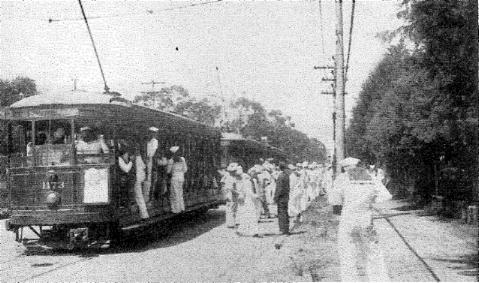
Sightseeing in Sao Paulo.
|
|
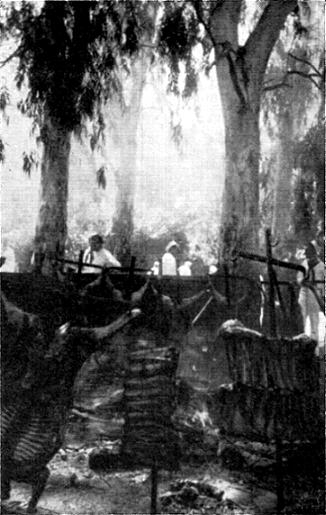
The "asado" given for members of the Helena's crew
at the Wilson Recreation Center.
|
An "Asado" (picnic) was given the crew by the Armour, Wilson and Cudahy Packing Companies at the Wilson Recreation Club, approximately thirty-five miles outside of Buenos Aires. It was a grand spread and the last bus pulled out leaving untouched beer behind. Mr. Armour, Minister to Argentina, brought Captain DeMott out to show him how the HELENA cowboys fell off horses gracefully. Two "gauchos" (cowboys) were on hand with all the trappings to instruct the Americans in the art of tossing the "boleadoras" (three rawhide-covered monkey-fists on three pieces of line about a yard long joined together and used as a lasso) and the use of the "rebenque" (a combination horse whip, leather stretcher and blackjack). Some of the more adventurous drank the native beverage, "Mate." Looks like dry alfalfa and when crumbled into the native gourd, or "cincelado," with hot water poured over it makes a drink for which one has to acquire a taste.
The largest refrigerating plant (Frigrifico) in the world is in Buenos Aires with a daily capacity of six thou-sand cattle and ten thousand sheep. We didn't get to see this, however, as the beer and horses took up most of the day. One sightseeing trip to Tigre, a summer resort forty miles up the Plata, was enjoyed by several sailors who wanted to see how the other half lives. One of the bigger surprises was the Graf Spee boys and the liberty they enjoyed while interned in the Immigracion Hotel. They're all over town and several came aboard for chow and to visit. The anti-Nazi feeling isn't near as intense as in Montevideo, which is probably the reason the TACOMA was used to take them there. The first impression everyone got was that the crew of the Spee was made up of exceptionally young men, very few being over twenty-two or twenty-three years of age. When the Achilles, one of the three English cruisers that ran the Spee into Montevideo, put in to Buenos Aires for supplies the city police were almost doubled in expection of another miniature war, but to everyone's amazement the English and German boys were seen every where together and having a hilarious time.

Helena bluejackets participating in Carnival Day in Santos.
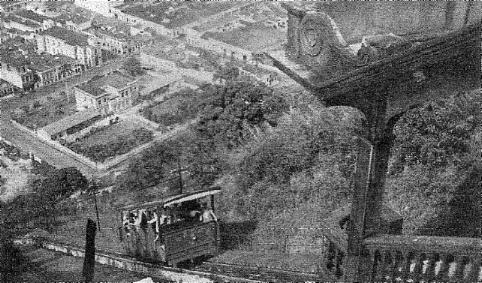
Cable car to Mt. Steratt.
|
|
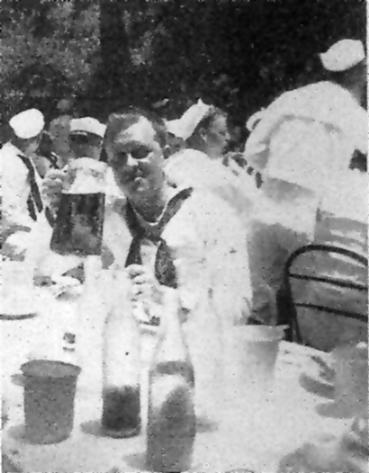
At that "asado" where a man could raise and quench a thirst.
|
The Argentine Navy is very small compared to other great powers of the world but among South American countries, Argentine and Brazil have the most up-to-date and largest navies. The United States maintains three naval officers to assist on the staff of the Argentine Naval War College. These officers are known as Naval Advisors and reside in Buenos Aires. On my first liberty I happened to be looking for a post office and accosted an innocent looking civilian headed toward the dock with, "Speekee English?" He came back with, "Hell, yes, Bud, what can I do for you?" Turned out that he was Aviation Machinist's Mate First Class Jack Schnell, from Anacostia and points north. Two enlisted men-one AMMlc and one RMle -are attached to the Naval Advisory at $3.95 per diem. Schnell is about ready for Anacostia again but the radioman just reported in from the Fleet. Gorrie, ex-chief Yeoman, is secretary to the American Consul and has a swell civil service rating.
Leaving Buenos Aires at 2000 on January 29 with all searchlights playing to the crowds on the dock and both national anthems getting cheers that could be heard long after the tugs shoved off, left no doubt as to the gaining popularity of the North Americans.
An overnight's slow run of 120 miles east-southeast brought us to Montevideo, the largest sea port and capital city of Uruguay. Uruguay is the smallest South American Republic with an area only slightly larger than the combined states of New York, New Jersey, Massachusetts, Vermont and Connecticut. Entering the roadstead we could see the hulk of the Graf Spee looking almost as if she were anchored with so much of the top side showing above water. What an eerie sight it was in the early morning hours! The former German raider was scuttled only six miles from the Custom House Docks and can easily be seen from anywhere along the water front. A Uruguayan patrol boat is anchored close by and will not allow anyone aboard. The Spee's wounded and dead were brought ashore here and thirty-seven of the wounded are convalescing at the Hospital Militar. Two have died since the battle but the others are expected to come through. They get liberty twice a week if some German resident of Montevideo will agree to see them around town or have them to his home.
Sightseeing was possible for the crew in Montevideo through the efforts of Mr. Karl Van Domselaar, former University of Michigan athlete, who went along and explained all the sights to us in good American slang. We visited several parks and the most interesting buildings in town. The statue of General Artigas, the George Washington of Uruguay, was most impressive but by far the most interesting sight was the Legislative Palace. Mr. Van Domselaar secured a guide to explain the mosaics, paintings and the congressional chambers. The Uruguayan Constitution provides for a President, a Chamber of Deputies of ninety-nine members and a Senate of thirty members, all of whom are elected for a period of four years. The present incumbent is General Alfredo Baldimor who assumed office in 1938.
Rambla Presidente Wilson is one of the most prominent drives and was named in honor of our war-time president. The beaches are considered the best south of Rio de Janiero and a large summer colony centering around the Carrasco Hotel and the resorts of Playa Ramirez and Pocitas are considered the most cosmopolitan in South America. The city itself is divided into two parts, the old and the new, and has a population of approximately 700,000. It was once enclosed with walls and defended by small forts but only small sections of these remain. The government buildings, large retail stores and most of the fine residences are in the Ciudad Neuva, or New City. Although the population is almost completely Spanish, the city has an Italian name meaning "I see the mountain." It got its name from the Italian explorer who first sighted the high hill on the left going into the harbor.
Tried to contact Jimmy Brown, the NBC and MGM representative in Montevido who made the radio scoop of broadcasting the scuttling of the Spee, but he was in Buenos Aires at the American Club.
It rained almost all of the five days we were in Montevideo but after leaving on the morning of February 3, we hit the hot tropical sun and it was with us until after two days in Santos, Brazil, where we tied up to the coffee docks on February 5. Santos is known the world over as a great coffee exporting center but few people realize that there are between eight and thirteen million bags of coffee shipped from there annually making it the world's greatest coffee port. One of the largest ports of Brazil, it is situated two hundred miles south of Rio de Janeiro which it exceeds in exports. Although it has some narrow winding streets, one is impressed with the modem warehouses, parks and business houses. The harbor is natural and well protected from the sea with a channel about five miles long connecting the open sea with the inner anchorage. Reminds old Diego sailors of the channel from the roads to the Fifth Street Landing except that in Santos the tropical growth and beaches are more noticeable. Some of the officers from the U. S. Naval Mission in Rio de Janeiro met the ship but no one was able to make the two hundred mile trip north as the connections were bad and the time short. One of the most interesting sights in Santos was the view of the city from the top of a small mountain reached by a cable car. With a population of about 175,000 people, the business life of Santos is reaching a peak as in all of the South American port cities. Rain falls on the average of 270 days a year which helps to keep the temperature down. A very old city, it sits at the foot of a range of mountains which form a plateau for the second largest city in Brazil, Sao Paulo.
The American and British colonies were exceptionally nice and some of the crew enjoyed a soft ball game and eats at one of the beaches. The SS ARGENTINA out of New York was dressed down in a baseball game previously arranged in Buenos Aires. No sooner had we tied up to the coffee docks than Mr. Krug, Business Manager of the American Chamber of Commerce in Sao Paulo and Georgia Tech '19, came aboard to make arrangements for sightseeing trips to Sao Paulo on the Sao Paulo Railway. The trip to Sao Paulo from Santos is one that no travel enthusiast should miss. After boarding the train, passengers notice nothing out of the ordinary until coming to Cubatao where, if it is pointed out, one can see where Ripley got his idea of oysters growing on trees when the tide is out. Although there are several cable railways throughout the world, the Sao Paulo railway is definitely outstanding on account of the heavy traffic it has to handle and its unit train loads vastly exceed those of any other cable railway. Having to overcome the tremendous obstacle of the high range of mountains known as the Cerra Do Mar, it rises to a height of 2725 feet in a distance of seven miles by a series of lifts. Not only is it a triumph of engineering skill, but the line runs through scenery of surpassing beauty. From the windows of the coaches, passengers obtain views of natural beauty hardly equalled on the continent of South America. Rudyard Kipling visited here in 1927 and a poem dedicated to the unique railway is inscribed on a plaque halfway up the mountain.
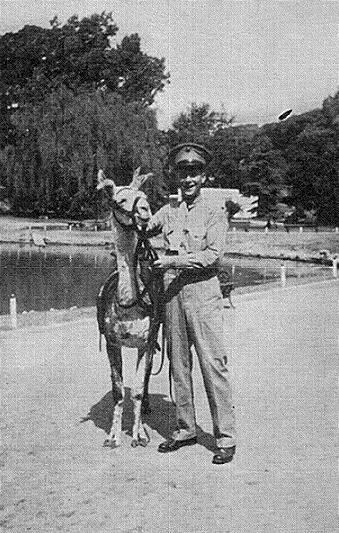
Jones, Pfc, USMC, makes friends with a Llama
at Palermo Park Zoo.
|
|
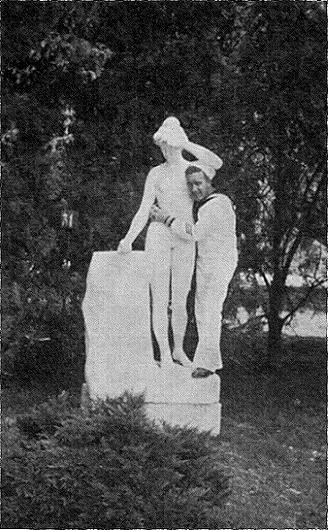
McKellard, Bug1c, discovers some fasinating fauna
in another part of Palermo Park.
|
After reaching Sao Paulo, sightseeing parties boarded street cars and were shown the town from one end to the other. After a lunch everyone went his own way and was advised as to where to meet the afternoon train back to Santos.
With six hours to look around, most of the boys headed for the snake farm at Butantan, a short distance out of town. The keepers went out of their way to show the more curious the method of obtaining the venom used as antitoxin for snake bites and poisonous stings. The "serpentarios," or snake arenas, are literally crawling with every conceivable kind of poisonous reptile but the attendants don't seem to mind walking over a dozen cobras to pick up a rattlesnake with a long rod on which is attached a metal hook. They have on forceps and glass dishes. By squeezing the neck of the snake, its mouth is forced open and the two sharp fangs are disclosed; issuing from the poison glands at the root of the fangs in the upper jaw is seen the deadly poison which drops into the glass receptacle. Frequently the attendant breaks off one of the brittle fangs with the forceps and he will then rapidly disclose a new tooth ready to take the place of the broken one. This breakage often happens when the snake in biting strikes a hard sub-stance but a new fang or tooth quickly grows back.
Mr. Krug, being a member of the Chamber of Commerce, is deluged with letters from the States wanting to know about jobs in Brazil and South America. His advise to aspiring young men and women is not to come to South America looking for a fortune. As a matter of fact, the different governments are stressing the employment of home talent so much that most of the United States firms are gradually replacing clerks, semi-skilled labor and minor afficials with natives.
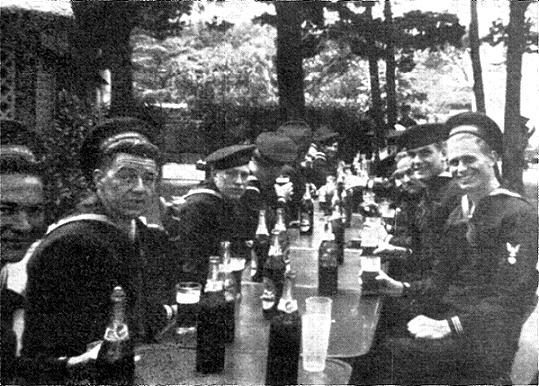
A Montevido sightseeing party stops for a well-earned rest.
|
|
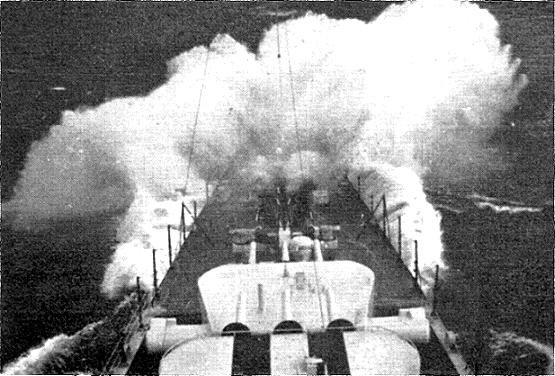
The Helena plows her way northward from Guantanamo Bay to New York.
|
On the way back to New York the HELENA put in at Guantanamo for the week end to rest up after structural firing. The Chiefs played the "M" Division in soft ball but no one has decided who won the game. It seems that a double header was split but the official counting as to who won the first game, or the last game, is unknown and thereby lies the stone that gathers no moss.
We stopped at Pier Seven in Norfolk to discharge the aviators and the very popular orchestra that goes to sea in May for assignment. On March 2, twelve thousand miles of shakedown were checked off by the crew of the Helena, which is a far better ship in more ways than one for this cruise, Uncle Sam's newest cruiser will be ready soon for a berth in man-o'-war row after a few checkups by the Brooklyn Yard. Watch out, Fleet here we come!












